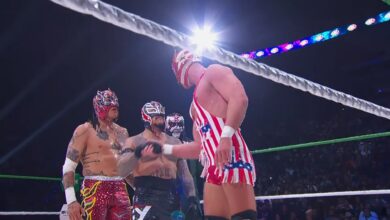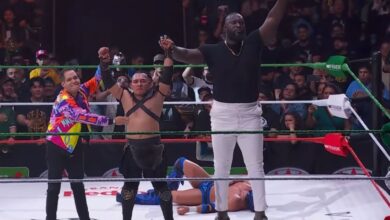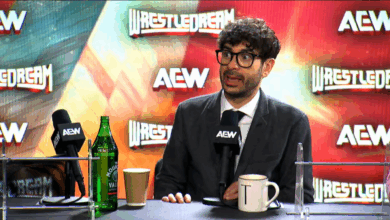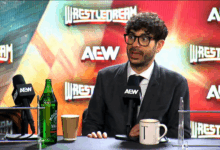Mike Bailey: Kayfabe Does Wrestling A Disservice, We Should Let Fans See The Process
“Speedball” Mike Bailey discusses the new Keep It Kayfabe documentary, which follows his journey on the independent wrestling scene as he wrestles 11 matches throughout WrestleMania 39 weekend.
“Speedball” Mike Bailey is currently in AEW, but before he was signed to a major company, he was one of the top independent wrestlers in the world. He’s now the subject of a new documentary, Keep It Kayfabe. During the documentary, Bailey pulls the curtain back on the world of independent wrestling during one of the busiest weekends of the year.
Speaking about being approached to be part of the documentary, Bailey told Fightful’s Sean Ross Sapp in a new interview that it all started with a random message. He certainly receives plenty of those, but this one led to something special.
“That was 11 matches in three days. It was just a random message of which I get many as a professional wrestlers, most of which don’t turn into anything. Or I don’t even respond to because the person sending it, you go on their profile and it’s all just a bunch of weird stuff, but Michael with Overlay films had done a lot of really great work in the past. They’ve done a lot of commercial work and short films and stuff that looked really beautiful aesthetically, what they did was very special. So that got me hooked right away and then a conversation started happening. When I found out what they wanted to do for a documentary, I was like, ‘This is perfect. This is exactly what pro wrestling, especially independent pro wrestling needs as an art form for people to see the side of it that they’re trying to show.’ So I was on board from then on,” he said.
Kayfabe is the practice of protecting the art of performance and making fans believe that professional wrestling is a genuine spectacle. Speedball thinks that the practice of wrestlers keeping kayfabe and attempting to be closed off to fans does a disservice to wrestling. He believed that for more people to watch wrestling casually, they need to understand the art form and be let in on the secret.
“I am always happy to be fully open about professional wrestling. Part of what I love so much about Keep It Kayfabe is that I think kayfabe as a concept does a huge disservice to professional wrestling as an art form. I think it’s bad. I say this in the documentary at some point, but I think if you wanted to get more people who kind of watch it casually to really understand pro wrestling, or people who don’t know pro wrestling, to really understand the art form, you would show them the whole thing.
“Because what you see as a pro wrestling fan when you’re watching it on TV or even live at a show is only the tip of the iceberg, right? If you wanted to see what professional wrestling really is, you would show them the entire process. You would need for the audience to understand that those are two real individuals who exist and have entire lives and watch them travel from possibly both complete opposite ends of the world, meet up in a room, speak in a maybe broken English, different language using pro wrestling terms, and then kind of come up with something in 20 minutes, shake hands, and then meet in the ring and perform a flawless fight scene choreography that needs to be good in one take, valid from all angles, and interactive with the audience. I think that entire process is the most beautiful thing about professional wrestling, not just the match itself.”
Of course, kayfabe and the general practice of maintaining it can be an effort to persuade fans not to question the legitimacy of professional wrestling. Bailey discussed his feelings about whether wrestling is fake. It’s a question he finds fascinating, and he believes the answer is complex, but he tries to give a genuine response throughout the documentary.
“I think, ‘Isn’t it fake? or ‘Do you know it’s fake?’ is such a fascinating question because it’s so complex to answer. I think Keep It Kayfabe does a better job than any other media has at answering that question, ‘Isn’t it fake?’ Yes, but also no. It really takes 75 minutes and 11 matches in 72 hours in order to properly answer that question, because it’s not not fake, but also clearly it’s not fake. It’s really happening and again, that’s so incredibly complex, and you need to watch the documentary in order to be able to answer the question.”
Furthermore, “Speedball” Mike Bailey said he believes the documentary does a good job of capturing the magic of professional wrestling, as he wrestled nearly a dozen matches during WrestleMania weekend in 2023. Since many of the matches on the independent circuit don’t receive the lengthy buildup that TV wrestling matches do, he believes the true art of wrestling lies in being able to tell a unique story inside the ropes that fans can appreciate without prior context.
“I think it really does a great job showing what pro wrestling is, right? Pro wrestling is portable, it’s replicable, it needs to be sustainable. So much of what is presented as like the most mainstream pro wrestling requires a very specific scenario in order to be valid. There are so many of the matches that are regarded as the world’s greatest matches that do not work out of context. If you don’t know the month-long build-up to them and they were to happen in any other setting, they would not work. But really, I think being a good professional wrestler is being able to make the most out of the setting that you’re given.
“I think it takes great skill to be given a scenario that takes six months to develop and then work that to its best,” he continued. “The art of professional wrestling is, even in the worst case scenario, even if it’s you have four matches. They’re all going to be different in front of an audience that probably doesn’t know who you are. You’re going to have to explain during the match why we’re doing a show at an emo night, what is going on, why we’re going to be singing in this match and it’s all going to have to make sense, and the audience has to understand it. I think that is where you can see what needs the most skill in order to be attained.”
Continuing, “Speedball” Mike Bailey praised the documentary’s authenticity. He discussed the difficulty of what he was tasked with over those three days and said that Christian O’Keefe and Michael Priestley, the directors of the piece, did a great job of not interfering and didn’t require him to change his approach to wrestling while capturing footage.
“I think they did a great job letting me completely forget that they were there. Also the demand for what I had to do in those three days is so great that honestly, the main difference for me that I had a documentary crew is that I had someone to drive me around and didn’t have to Uber back and forth from the UCC to the U.S. That was the best part. We would talk in the car and that was it. The rest of the time I was just doing what I was doing because I would have had no room in my life to do both—to like film a documentary that required me to act different, but also to wrestle Kota Ibushi, Hiroshi Tanahashi, Irie, and do the fucking Battle Bog all in the same day while doing other things. That’s what they wanted. They wanted just raw Speedball Mike Bailey doing pro wrestling and that’s what they got there. I changed nothing for the documentary.”
The world premiere of Keep It Kayfabe will take place on Thursday, July 24, at San Diego Comic Con. There will also be a Q&A session with Mike Bailey. For more on the film, check out an interview with the documentary’s directors, Christian O’Keefe and Michael Priestley, currently available on Fightful Select.
You can check out the full interview with “Speedball” Mike Bailey embedded above.




